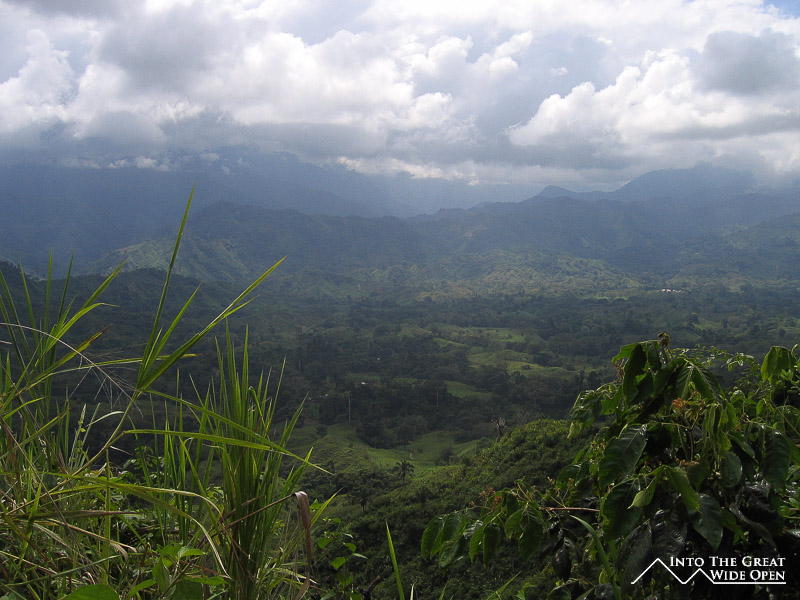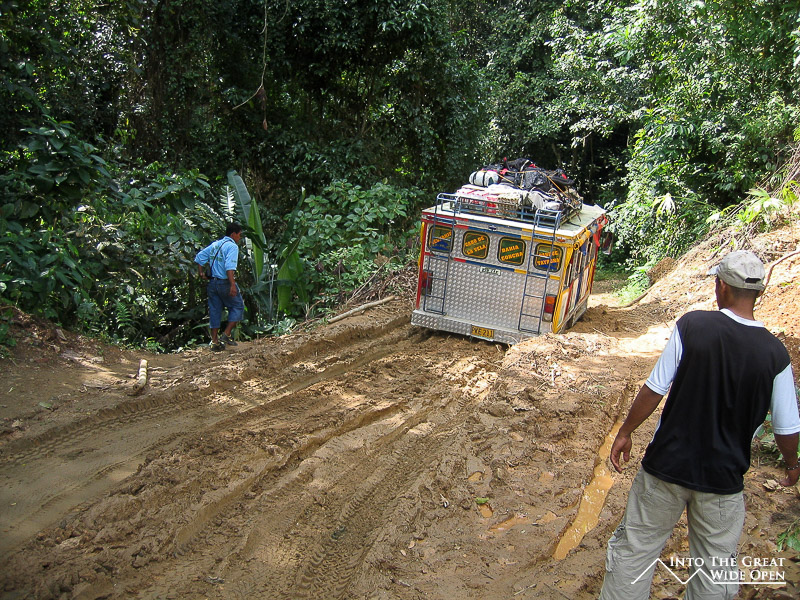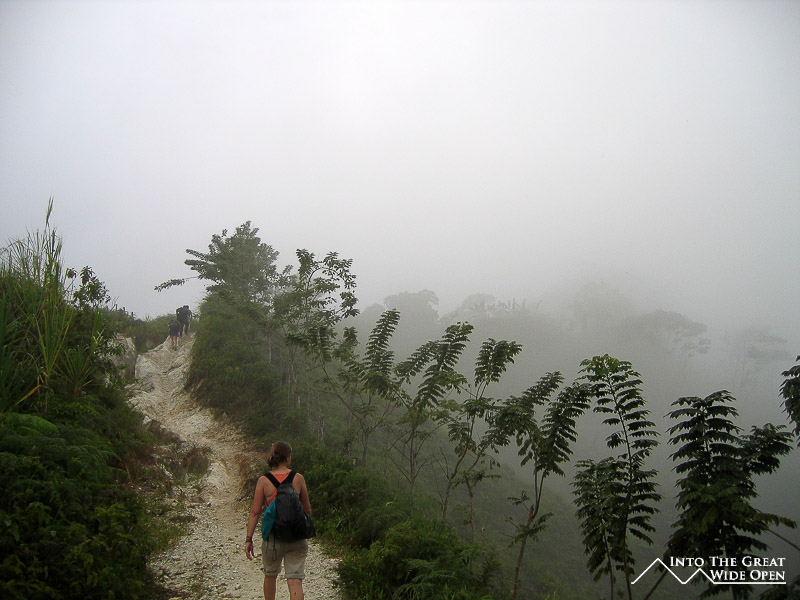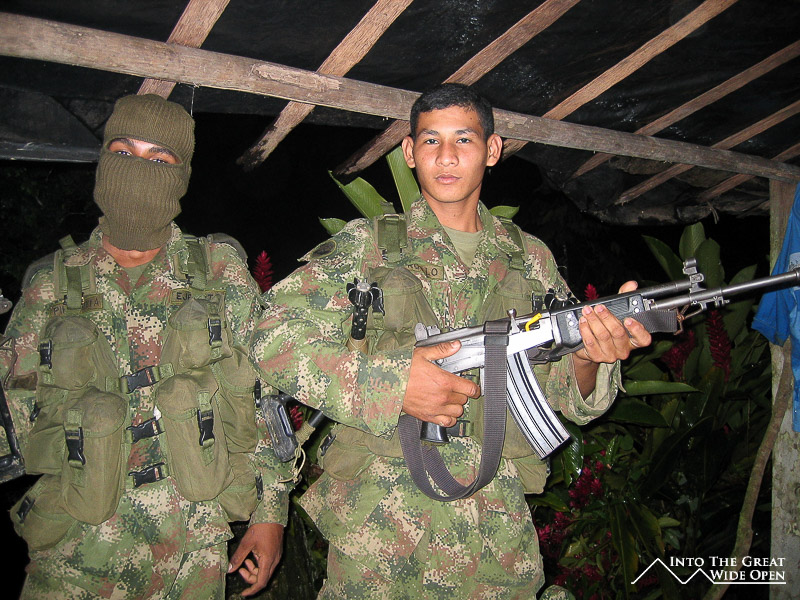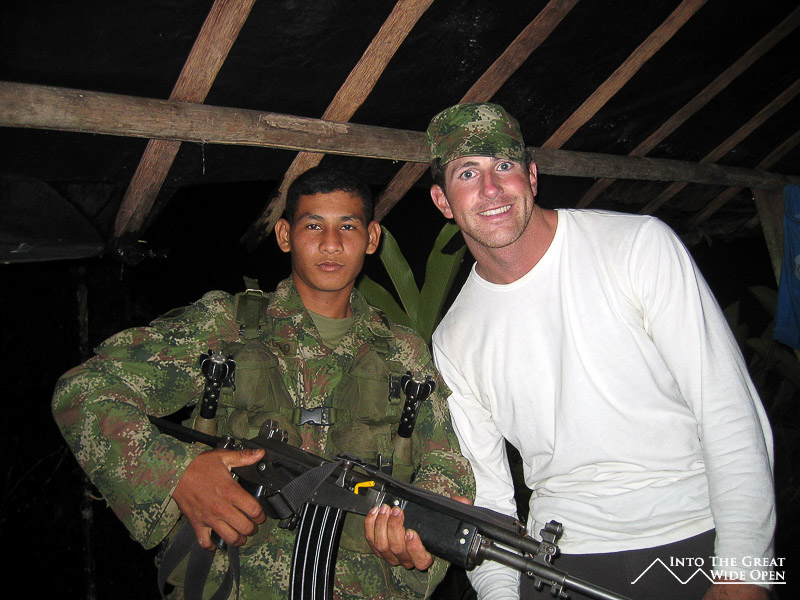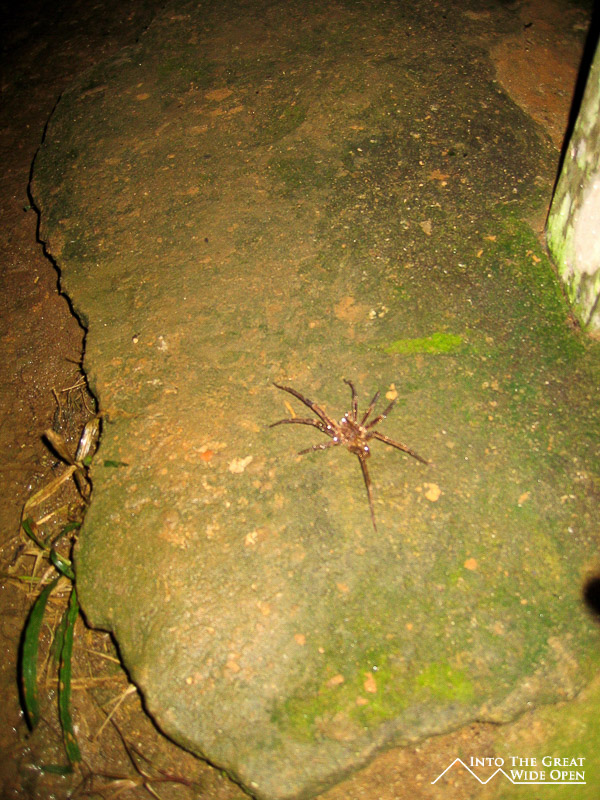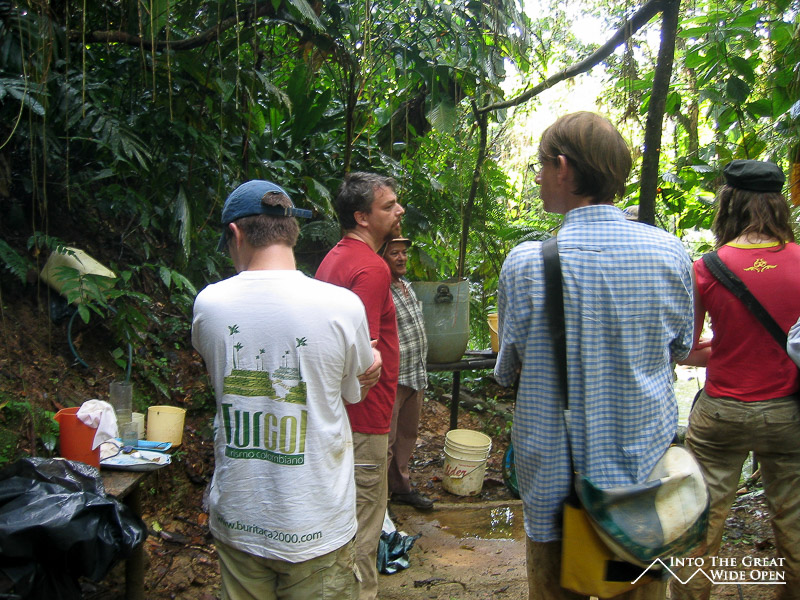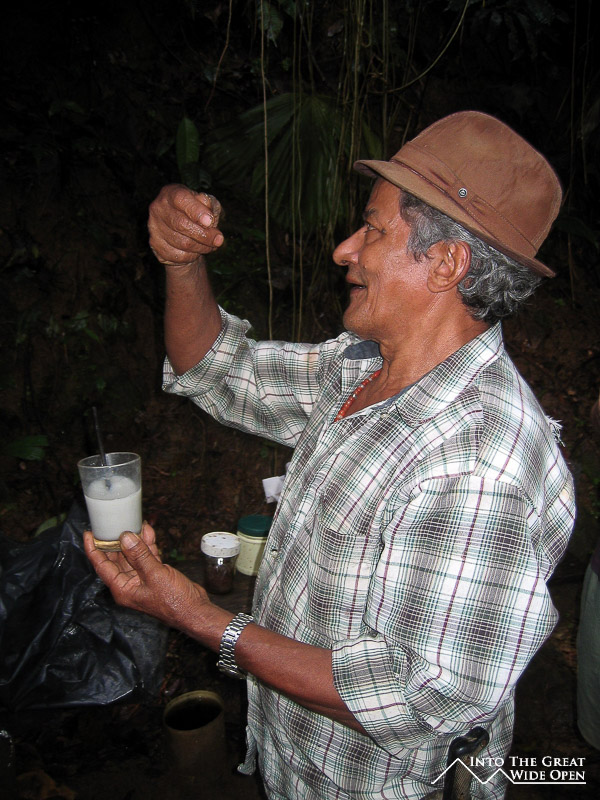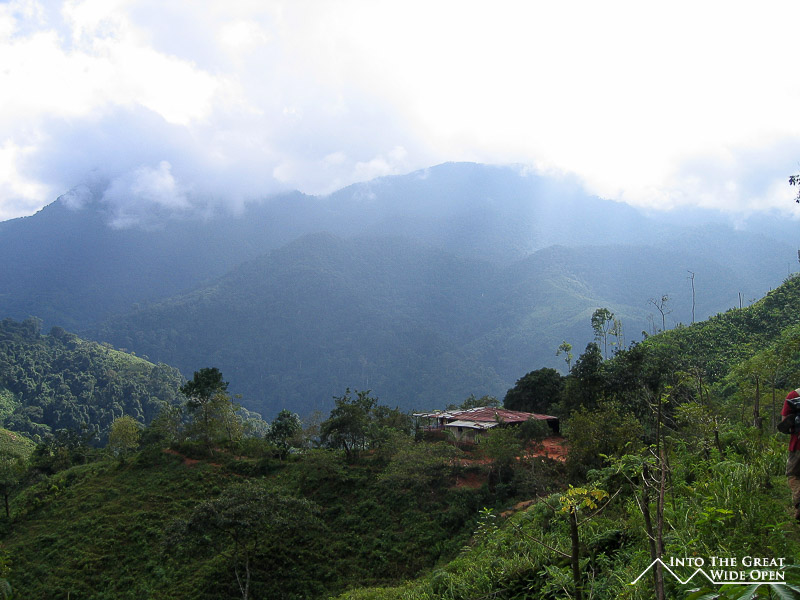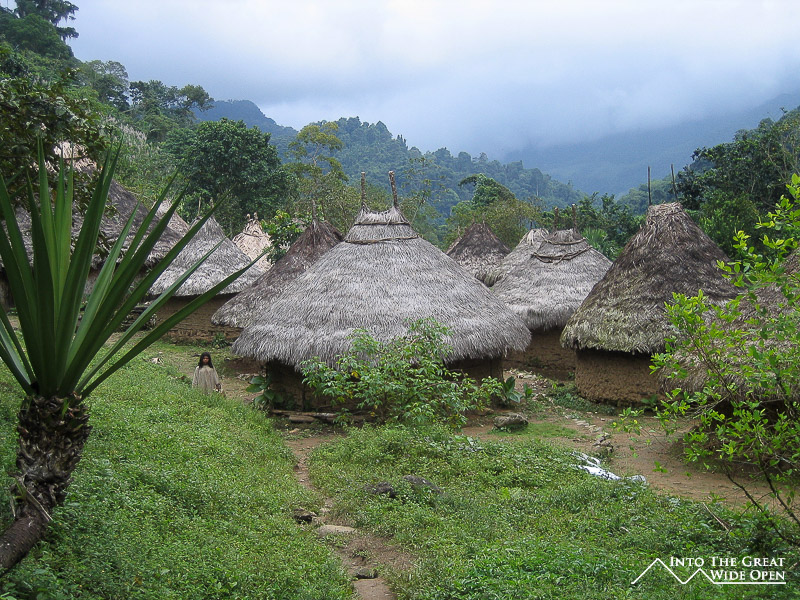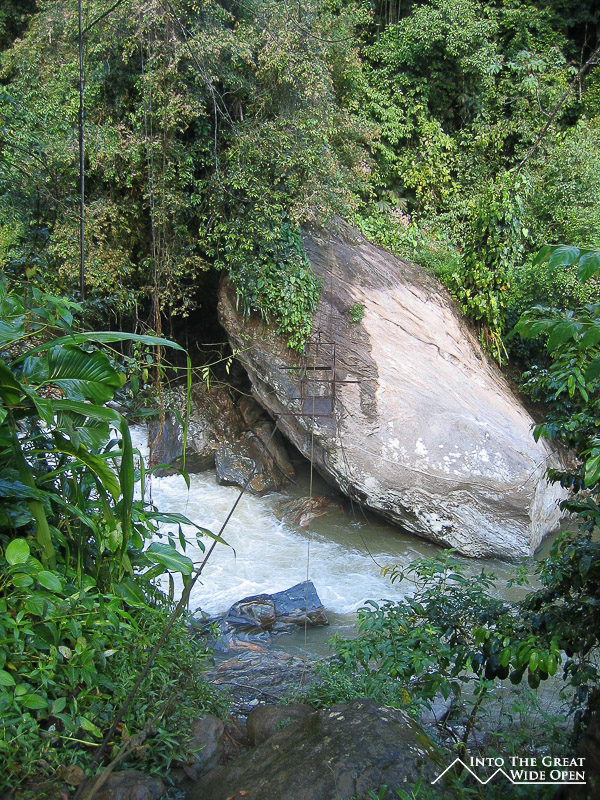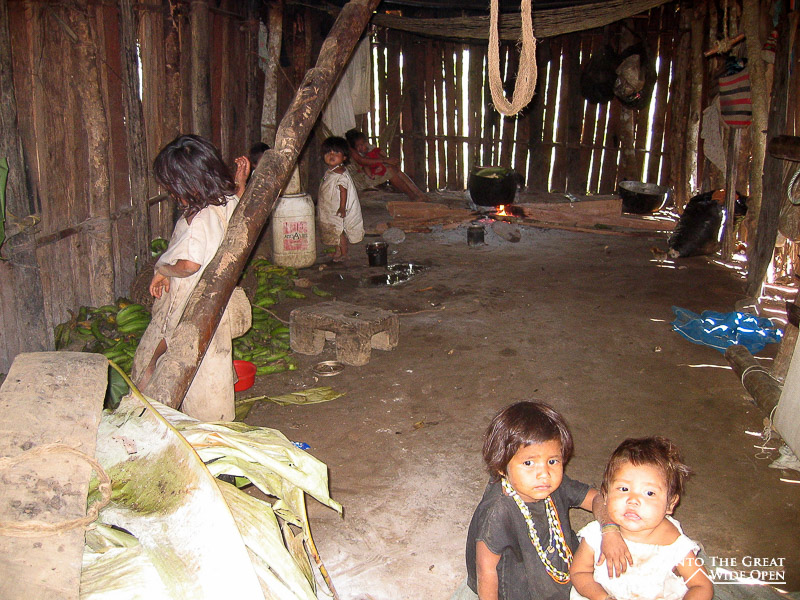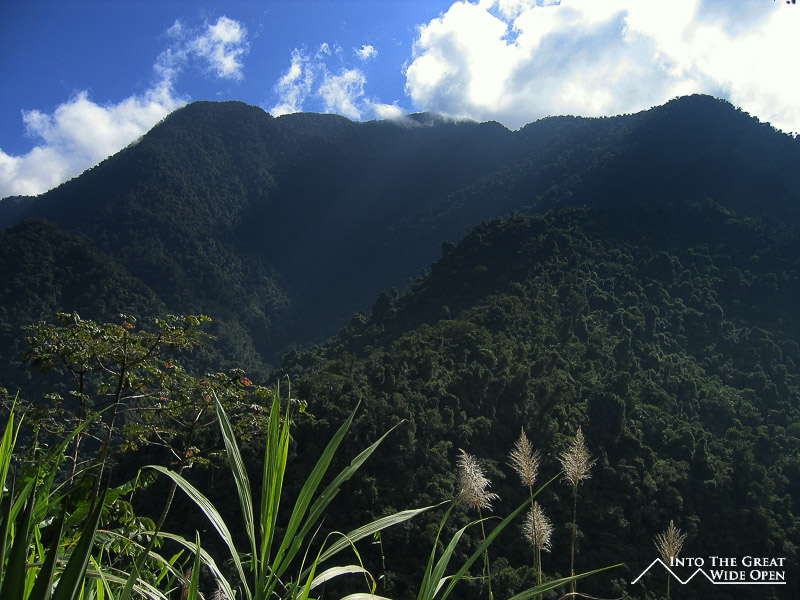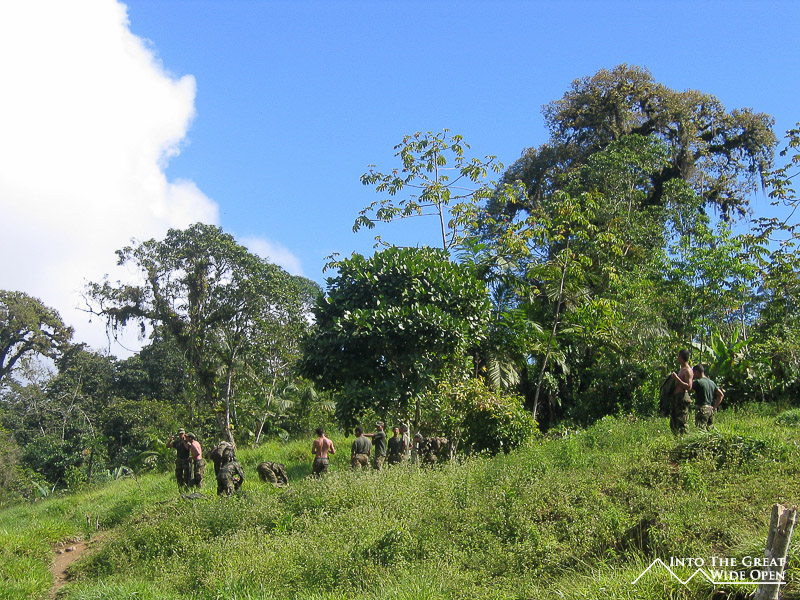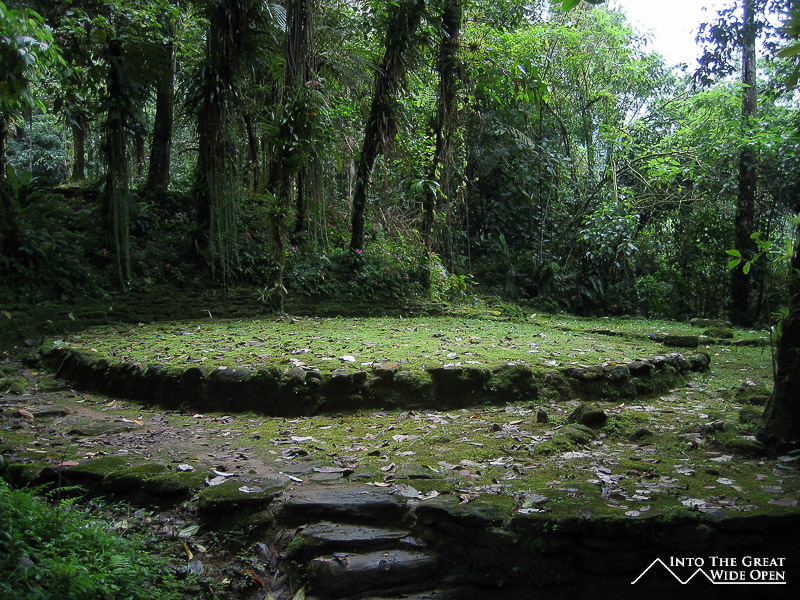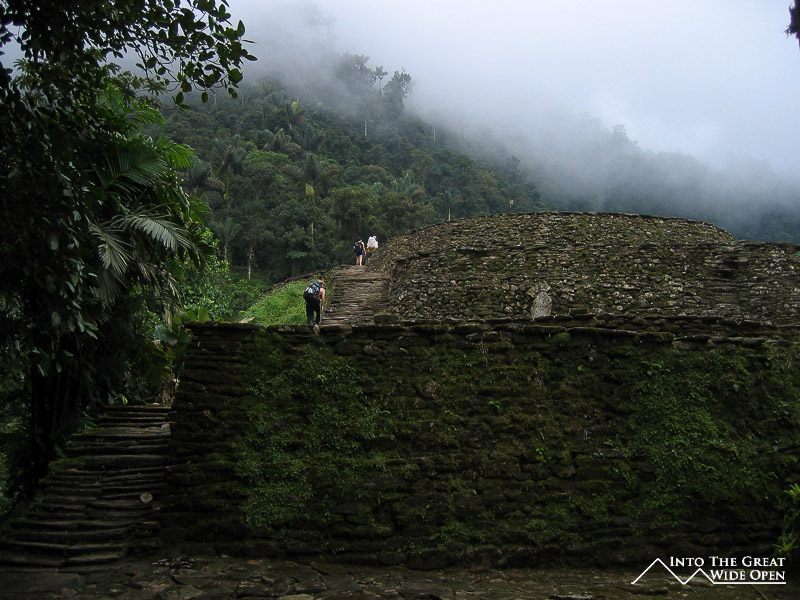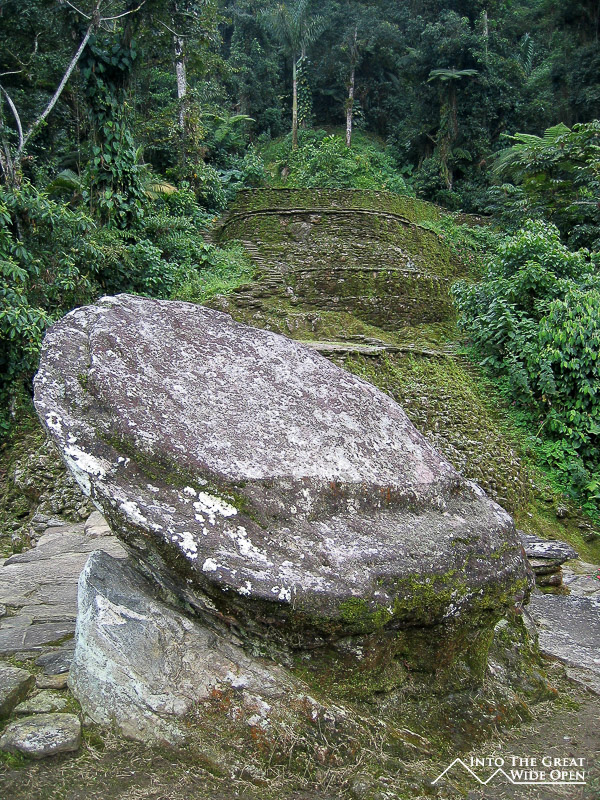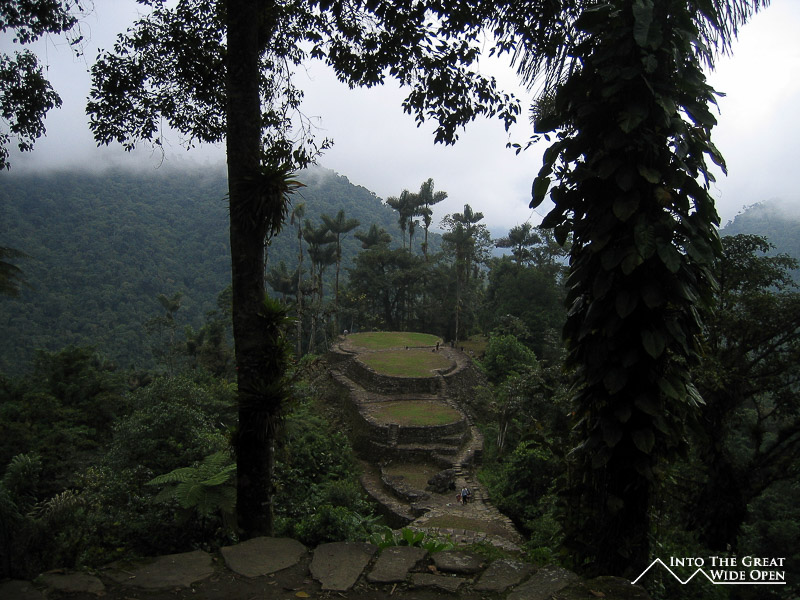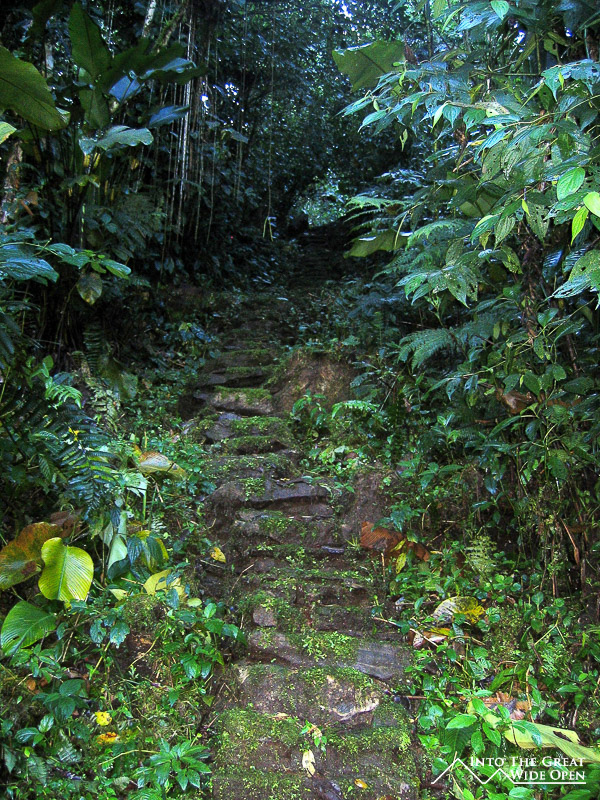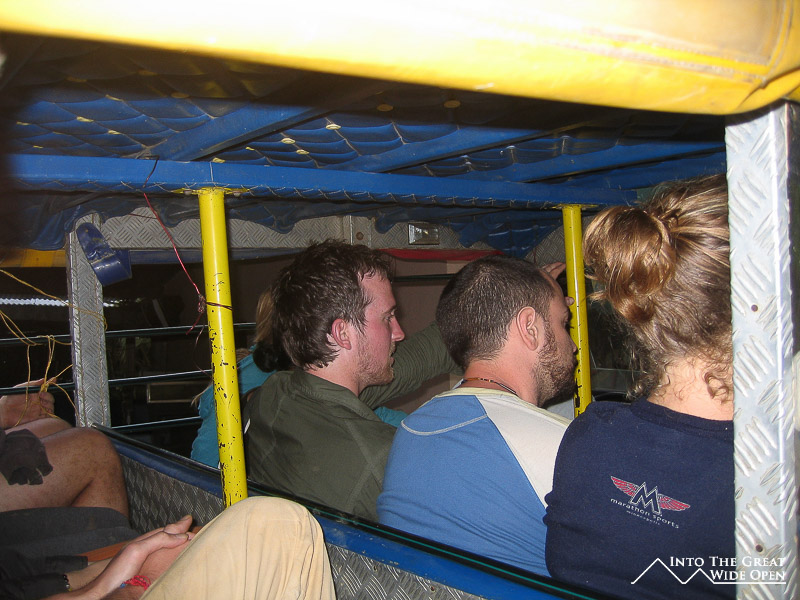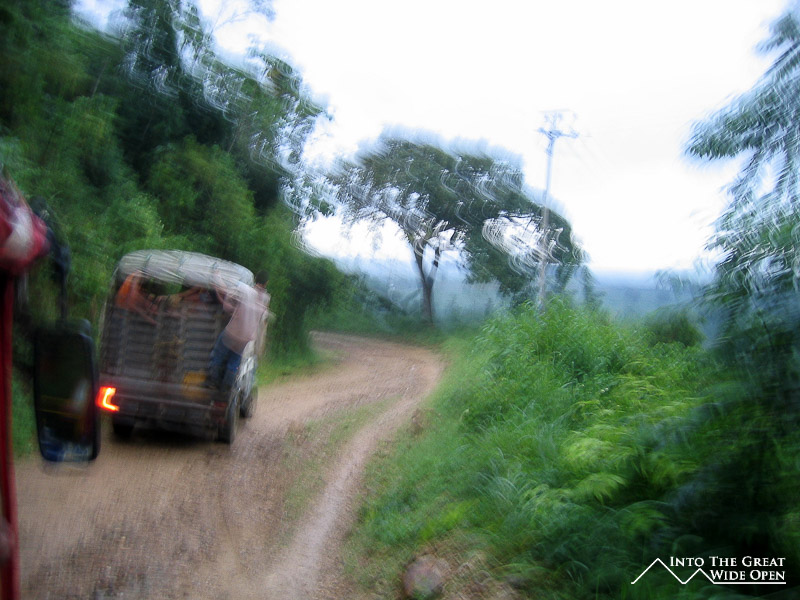Ciudad Perdida, Colombia
The Trek to the Lost City
December 23, 2007
Man may live and man may die searching for the question why
But if he tries to rule the sky, he must fall
- Cat Stevens

I am deep in the Colombian jungle, 10 minutes from where we spent the night with the Colombian military, and this guy is showing us how to make cocaine from scratch. But that probably isn't the best place to start the story. The story starts with the jungle, and the reason for going to the jungle was to hike to Ciudad Perdida, a six-day journey from the edge of civilization into the heart of the jungle. Our group consisted of 12 people, two Italians, two South Africans, two Germans, four Americans, one Colombian, and a Dutch girl, plus our two guides.
In order to even reach the beginning of the trail we needed to take a 3-4 hour jeep ride from Santa Marta to the trailhead. The chiva or jeep that the tour operator provided was an old Toyota Landcruiser which was colorfully painted and looked more than rugged enough for any purpose. Eight of us, plus the two guides and a driver, piled into this outlandish vehicle with all of our belongings and other provisions lashed to the top. The other four went in another vehicle as there wasn't enough room in the jeep for everyone. The first part of the ride was slow as the loaded jeep couldn't manage more than 40 mph, so it took us over an hour to get to the turn-off from the paved road to the dirt road that led inland to the jungle. Once we reached this point, the road began to slowly deteriorate until we needed every bit of four-wheel drive power that the jeep could muster and unfortunately, this wasn't always enough. I was sitting on the edge of one of the rows with a little door comprised of bars and a small ledge that went up to my hip, with the whole upper part open up to the support beams for the roof so I had quite a good view of the road we were going over and of what lay beyond the side of the road.

The first time we got stuck was trying to cross this section of muddy road with tire ruts over a foot deep. As the driver revved the engine and the jeep started to slow and sink into the mud the whole vehicle angled over totally towards my side. When we came to a stop I had a nice view of the tire which was about 18 inches from edge of the road which then dropped of into a ravine about 60 feet straight down. At this point we all had to get out of the jeep so the driver could back it up and try to make it through this section again, which they were successful in doing without our added weight. Later on, we were forced to stop and get out another time, only to discover that the steel on the tire around the lug nuts had a 4-inch long gash in it. After the driver and guides agreed that it looked okay to continue, they tightened the lug nuts and we proceeded.
Several minutes later the driver felt that the wheel wasn't holding up so we all had to get out, move the provisions from the roof, pull down the spare tire and change the tire amidst the mud on the road. Soon after this we got stuck again. This time the jeep couldn't even make it through the mud without us so we were forced to push the jeep through this 4-6 inch deep mud. There were several other close calls but we were able to make it to the little village located at the trailhead.
Over lunch in the village the people in the other vehicle said that they were scared watching us drive because the jeep would shift from side to side at such large angles. After lunch we started hiking into the wilderness. The trail was nice, we were all talking and getting to know each other, and we were able to cross a few shallow rivers without getting wet. Our food supplies had been loaded up on mules and had traveled ahead of us.

When we reached the first uphill stretch, it was rather steep and quite rocky but not terrible. Then it started to rain. This was probably why they had given us garbage bags before we started hiking. As the rain worsened we all donned plastic bags over our backpacks and continued hiking uphill. Then it started to absolutely pour rain and we continued to slog uphill past a military checkpoint and a little store in a shack selling drinks and snacks. After leveling out for a while the trail turned sharply downhill and at this point it was not so much a trail as a deep muddy chasm carved into the ground with a river of muddy water from the unrelenting rain running down the middle and off to the sides at every angle.
The trail and the rain continued like this for another solid hour, at which point we reached our campsite for the night and it continued to rain just as hard as ever. Everyone was glad to reach the campsite as we were totally soaked from the rain, but at least our backpacks were dry, courtesy of the garbage bags. We ate dinner and spent the night talking and hanging out with the Colombian military troops stationed there. We slept in hammocks because of all the giant frogs, spiders, and ants that are everywhere in this jungle, some of them poisonous. I guess that everything is bigger and more dangerous in the jungle.
When we woke up in the morning the soldiers had gone and this meant that we were able to take a side trip with a man that used to run cocaine factories in the jungle. He told us that the army had blown up two of his factories so he no longer did that. That would be the same army that stayed with us in the camp the previous night. They had moved on looking for and trying to destroy coca plants, as this whole region is prime coca country and there used to be heavy guerilla activity as recently as five years ago when several people were kidnapped at the Lost City. A heavy military presence has since moved the threat of any hostile activity much deeper into the jungle.
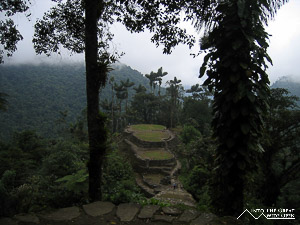
As the soldiers pushed further into the jungle this man walked us through the whole process of how to make cocaine from the raw coca leaves. It was really like one of those cooking shows where they pull out pots of the dish at various stages, like here is the mixture after baking for five hours and this is it after soaking in acid for several minutes, etc. The whole process was actually remarkably simple and anyone with access to a basic chemistry lab and a few kilos of coca leaves could make a few grams of cocaine in a day. In this day and age I am sure all the information is readily available on the Internet. The man showed us the process from the beginning all the way to the coca paste, which just has to be dried out to make the powdered cocaine. He offered us the opportunity to sample it so I rubbed a little on my sunburned lip and it was numb for about 30 minutes. Knowing all the chemicals that go into cocaine, the damaging effects it has on people are not surprising.
After our little cooking lesson it was off for another day of hiking, this time we were lucky enough to hike in the morning when it was dry and one only has to put up with the sweltering heat and humidity. Of course all of our clothes were still soaking wet from the previous day. Rule number one that I learned in the jungle is that anything that gets wet stays wet, unless it gets direct sunlight, the high humidity ensures that everything remains damp. After a short easy stretch of the trail, made even easier with the small sample of coca paste, it was straight uphill for 90 minutes of mud-slogging from all the rain that fell yesterday, and then downhill for about 30 minutes and then uphill for another 60 minutes.
At times we were hiking with soldiers in front of us and soldiers behind us, kind of an eerie feeling. There was obviously no threat as sometimes we would come to a clearing to find the soldiers hanging out washing their clothes with their machine guns hung up on trees or placed on rocks somewhat nearby, so they apparently weren't worried about anything. The trail crossed near the villages of some of the indigenous people and through some spectacular jungle scenery before ending at the camp where we caught up with the soldiers again. Even though it didn't rain we were all still soaking wet from sweating in the jungle heat during our four hours of hiking. We were able to swim in the river to wash off and cool down. As the afternoon came, it started to rain, and then it started to rain harder, until it was raining about as hard as it possibly could. It continued to rain like that for about 3 hours before slowly tapering off over several hours.
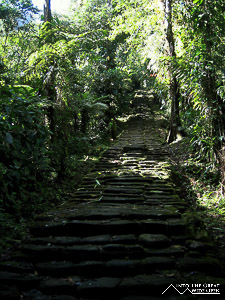
The third day was supposed to be the longest hiking day and we would actually reach the Lost City. The clear river that we swam in the day before was now a churning mass of muddy brown water from all the rain during the night. The first part of the hike started with us inching our way around the edges of slippery rocks that dropped away about 30 feet to muddy class 3 and 4 rapids in the river below. After that we had to cross the river through strong currents and quickly flowing waist deep water. The guides used a rope to pull us across the river to ensure that no one slipped and was washed away. More hiking through the jungle past other indigenous villages led us to a river which we hiked along and crossed back and forth about 7 times to avoid the various waterfalls. Then, all of a sudden we came into view of these small rock steps descending toward the river from the jungle.
This easily overlooked staircase was the entrance to the Lost City. Climbing up the steps, all 1,200 of them was tiring, some of them were really small and they were steep and slippery. It was amazing that there was a city located up on these mountains. Eventually we reached a clearing, which was the first part of the city, through this clearing more stairs led into the heart of the city and soon we reached the main staircase, which was much wider and seemed to lead straight up into the jungle. Coming up from the main staircase to the top of the Lost City was spectacular.
The Lost City is nestled in the shadow of giant mountain peaks with a terrace overlooking the surrounding valleys and lesser mountains. The whole city was crawling with soldiers; they even had their own command post, towards the top of the Lost City, looking down on it all. After some time wandering around the city we headed to the campsite where we had some food and settled in before the fog came in and the nightly rain started coming down. Naturally the guidebooks are wrong and the dry season doesn't start until January.
The next morning we had a guided tour of the Lost City. It was amazing to learn that over 2,000 people lived at the site in about 240 dwellings and only 30% of the site has been excavated because of a lack of funds. It was certainly a hard place to reach and I am sure it must have had great strategic value for its founders. Our guide also told us of another lost city, reachable only by helicopter unless you want to walk for seven days bent over at the waist and face a tribe that lives in caves and is hostile towards outsiders because someone stole their golden armadillo years ago (the armadillo was recovered and the thief murdered).
Spending the next morning at the Lost City was great, it was such a peaceful place in a beautiful location, and other than the few soldiers still milling around we had it all to ourselves; a distinct advantage over a place like Machu Picchu. After a leisurely morning we had to begin the journey back so it was down those 1,200 steep slippery stairs very cautiously, across the river seven more times and back to the last camp, a much easier hike this time because it was mostly downhill. We had to share the second camp with two other two groups so it was very crowded and we were relegated to our hammocks for a majority of the time because there was simply nowhere else to sit. Of course it was raining so it wasn’t like we could go explore the surrounding jungle. When it was finally our turn to use the tables we ate our food and began to play cards. As we were playing cards a dogfight broke out between two of the dogs that were hanging around.
The other group was sitting along a row of benches and the snarling dogfight moved itself under the bench leading everyone to hurriedly pull their feet up as the dogs savagely bit and clawed at each other. No one could really break it up, some of the guides tried throwing water on the dogs but they continued to go at each other. Then, one guide reached in and grabbed one of the dogs by the hind leg and pulled it out from under the bench and away from the fight. I'm not sure if the dogs would have fought to the death but they were very intense. Additional dogfights almost erupted a few other times but the guides were able to prevent it. Because we were all tired of wearing the same wet clothes and we would have had a short and easy hike the next day, our group had decided to hike the rest of the way out in one day rather than two.
The down side of this was that we needed to start at dawn in order to get out of the jungle and into the jeep before the afternoon rains that would make the road impassable. Hiking out was much easier than hiking in because it was mostly downhill with only two big uphill stretches. We made great time and made it out to the village at the trailhead a bit after noon giving us plenty of time to change out of our wet clothes, relax, have a couple beers and lunch, and wait for the jeep to come and pick us up. Because we hiked out faster than scheduled we had to share the jeep with another group of four and their guide. This forced three people to take motorcycle taxis out to the main road because the jeep couldn't take all of us. We waited a few hours before the jeep finally came and at that point it looked as if it was going to rain any minute. The questionable road would obviously be less than drivable if it really started to rain.
We loaded everything onto the roof of the jeep and we piled in, this time there were 15 of us, with 13 inside the jeep and two of the guides riding on the roof. The overloaded jeep had some trouble with some of the sections and pitched from side to side even more, forcing all of us to dismount as it navigated some muddy stretches. At this point we were all wearing sandals and were not exactly prepared to slog through the mud. When we had to get out, the jeep would plow ahead and we would all have to run behind it in the mud with our sandals to catch up because the driver and the guides really wanted to get off the bad sections of road before it got dark. With all the extra weight the jeep was riding considerably lower to the ground and a few times tree branches and rocks hit the gas tank. One of the guides got out to check the tank several times and because he spoke the fastest Spanish that I've ever heard none of us could understand if the gas tank was leaking or not, however it certainly smelled like it was.
So to review, our overloaded jeep, which was possibly leaking gas, was hurrying through this rough road trying to make it out before dark. That was about when it started to rain. Fortunately it wasn't as bad as the torrential downpours that happened while we were hiking, but we did overhear one of the guides in the front say to the driver, "They should know that this is dangerous." Luckily enough we made it without incident to the better portion of the road where we passed a truck that had pulled over. Our driver stopped to inquire what the problem was and after a brief conversation we heard our driver say to the truck driver, "You really shouldn't go down this hill without brakes." Shortly thereafter we reached the entrance to the main road and the checkpoint manned by a group of soldiers. During the obligatory search for drugs to make sure that no one was smuggling drugs out of the jungle the soldiers got a good laugh when our driver told them there was a truck with no functioning brakes behind us; they probably thought it was a joke. Another hour and a half on paved roads and we were back in Santa Marta, back in civilization and out of the jungle after a long and eventful day.
